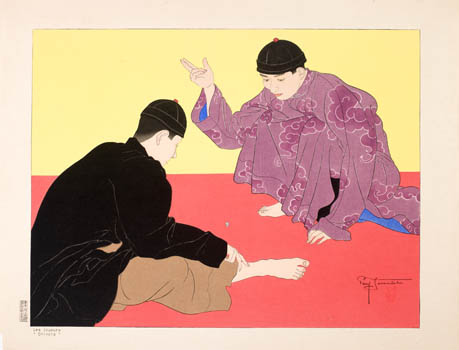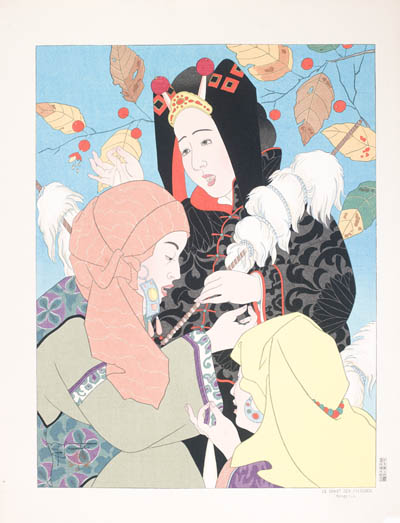Exhibits >> Souvenirs of Modern Asia >> China & Mongolia
While traveling in China and Mongolia, Jacoulet sketched the people, their customs and traditional dress. His sketches served as the basis for more than thirty color woodcuts. These demonstrate Jacoulet’s superb talent for narration and for depicting his subjects’ personalities and inner emotional states through gesture and facial expression. A number of Jacoulet’s woodcuts evoke the splendor of Imperial China which was losing its foothold in Northeast China as a result of the Japanese occupation of Inner Manchuria. Others show people engaged in everyday activities, such as the print Les Joueurs. Chinois (The Gamblers. Chinese). Jacoulet also depicted the people of Mongolia, a country with a long history of political ties to China, in prints such as Le Chant de Fileuses. Mongolie (The Song of the Seamstresses. Mongolia).


|
|
Les Joueurs. Chinois (The Gamblers. Chinese)
1941
Color woodcut print
Page size: 14 1/4 x 18 3/4 in. (36.2 x 47.6 cm)
Image size: 15 1/2 x 11 3/4 in. (39.4 x 29.8 cm)
Collection of Dorothy Finkin, courtesy of Eugene Finkin
© 2012 Artists Rights Society (ARS), New York / ADAGP, Paris
In Les Joueurs, two figures appear to float against an abstract background of bright yellow and orange-red. The subtle designs on the caps worn by the figures were achieved through masterful overprinting of grey on black and black lacquer on dark grey. As noted on the accompanying stamps in the left margin, the cherry wood blocks were carved by Maeda Kentaro (c. 1891-1987) and this impression was printed by Honda Tetsunosuke (active 1934-1960).
|
Le Chant de Fileuses. Mongolie
(The Song of the Seamstresses. Mongolia)
1958
Color woodcut print
Page size: 18 3/4 x 14 1/4 in. (47.6 x 36.2 cm)
Image size: 11 3/4 x 15 1/2 in. (29.8 x 39.4 cm)
Gift of Eugene Finkin in memory of Dorothy Finkin
2012.9.18
© 2012 Artists Rights Society (ARS), New York / ADAGP, Paris
Jacoulet’s prints typically depict one or two figures but rarely three as in this composition. Here, three women sing as they work against a background of botanical studies of leaves and berries. The figures’ faces and hands are very expressive and evoke an emotional response to their song. This print dates to the 1950s when Jacoulet had begun to design his compositions directly for the key-block, thus bypassing the need for his meticulous preparatory watercolors. He used gofun, an egg-white derivative to produce the rich opaque-white effect for the spools of thread. He also used silver, gold and bronze metallic pigments for the threads. The wonderful textures in the print were achieved with small embossing blocks, known as gauffrage.
|





